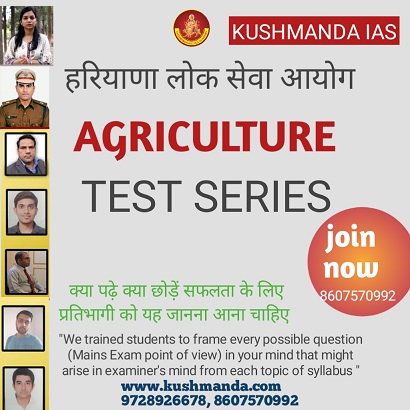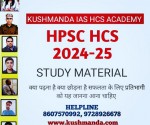HPSC HCS AGRICULTURE TEST SERIES 2023
HPSC HCS AGRICULTURE TEST SERIES 2023
Online Test Series : Offline Test Series
- Kushmanda offers Online Test Series For HPSC HCS AGRICULTURE with Detailed Explanations. Our Online Test Series is developed by Kushmanda Research and Development wing. Yet, they cover the complete Syllabus along with an in-depth Analysis of all Entrance Questions.
- Online Test Series is divided into two parts; such as Topic-wise Tests and Mock Tests along with detailed explanations.
AGRICULTURE
PART-I
Ecology and its relevance to man, natural resources, their sustainable management and conservation. Physical
and social environment as factors of crop distribution and production. Agro ecology; cropping pattern as indicators of
environments. Environmental pollution and associated hazards to crops, animals and humans. Climate change—
International conventions and global initiatives. Green house effect and global warming. Advance tools for
ecosystem analysis—Remote Sensing (RS) and Geographic Information Systems (GIS).
Cropping patterns in different agro-climatic zones of the country. Impact of high-yielding and short-duration
varieties on shifts in cropping patterns. Concepts of various cropping, and farming systems. Organic and Precision
farming. Package of practices for production of important cereals, pulses, oil seeds, fibres, sugar, commercial and
fodder crops.
Important features, and scope of various types of forestry plantations such as social forestry, agro-forestry,
and natural forests: Propagation of forest plants. Forest products. Agro-forestry and value addition. Conservation of
forest flora and fauna.
Weeds, their characteristics, dissemination and association with various crops; their multiplications; cultural,
biological, and chemical control of weeds.
Soil—physical, chemical and biological properties. Processes and factors of soil formation. Soils of India.
Mineral and organic constituents of soils and their role in maintaining soil productivity. Essential plant nutrients and
other beneficial elements in soils and plants. Principles of soil fertility, soil testing and fertiliser recommendations,
integrated nutrient management Biofertilizers. Losses of nitrogen in soil, nitrogen-use efficiency in submerged rice
soils, nitrogen fixation in soils. Efficient phosphorus and potassium use. Problem soils and their reclamation. Soil
factors affecting green house gas emission.
Soil conservation, integrated watershed management. Soil erosion and its management. Dry land agriculture
and its problems. Technology for stabilising agriculture production in rainfed areas.
Water-use efficiency in relation to crop production, criteria for scheduling irrigations, ways and means of
reducing run-off losses of irrigation water. Rainwater harvesting. Drip and sprinkler irrigation. Drainage of waterlogged
soils, quality of irrigation water, effect of industrial
effluents on soil and water pollution. Irrigation projects in India.
Farm management, scope, importance and characteristics, farm planning. Optimum resource use and
budgeting. Economics of different types of farming systems. Marketing management strategies for development,
market intelligence. Price fluctuations and their cost; role of co-operatives in agricultural economy; types and systems
of farming and factors affecting them. Agricultural price policy. Crop Insurance.
Agricultural extension, its importance and role, methods of evaluation of extension programmes, socio-
economic survey and status of big, small and marginal farmers and landless agricultural labourers; Training
programmes for extension workers. Role of Krishi Vigyan Kendra‘s (KVK) in dissemination of Agricultural
technologies. Non-Government Organisation (NGO) and self-help group approach for rural development.
PART-II
Cell structure, function and cell cycle. Synthesis, structure and function of genetic material. Laws of heredity.
Chromosome structure, chromosomal aberrations, linkage and cross-over, and their significance in recombination
breeding. Polyploidy, euploids and aneuploids. Mutation—and their role in crop improvement. Heritability, sterility
and incompatibility, classification and their application in crop improvement. Cytoplasmic inheritance, sex-linked,
sex-influenced and sex-limited characters.
History of plant breeding. Modes of reproduction, selfing and crossing techniques. Origin, evolution and
domestication of crop plants, center of origin, law of homologous series, crop genetic resources—conservation and
utilization. Application of principles of plant breeding, improvement of crop plants. Molecular markers and their
application in plant improvement. Pure-line selection, pedigree, mass and recurrent selections, combining ability, its
significance in plant breeding. Heterosis and its exploitation. Somatic hybridization. Breeding for disease and pest
resistance. Role of interspecific and intergeneric hybridization. Role of genetic engineering and biotechnology in crop
improvement Gernetically modified crop plants.
Seed production and processing technologies. Seed certification, Seed testing and storage. DNA finger printing
and seed registration. Role of public and private sectors in seed production, and marketing. Intellectual Property
Rights (IPR) issues, WTO issues and its impact on Agriculture.
Principles of Plant Physiology with reference to plant nutrition, absorption, translocation and metabolism of
nutrients. Soil-water-plant relationship.
Enzymes and plant pigments; photosynthesis—modern concepts and factors affecting the process, aerobic and
anaerobic respiration; C3, C4 and CAM mechanisms. Carbohydrate, protein and fat metabolism. Growth and
development; photoperiodism and vernalization. Plant growth substances and their role in crop production. Physiology
of seed development and germination; dormancy. Stress physiology—draught, salt and water stress.
Major fruits, plantation crops, vegetables, spices and flower crops. Package practices of major horticultural
crops. Protected cultivation and high tech horticulture. Post-harvest technology and value addition of fruits and
vegetables. Landscaping and commercial floriculture. Medicinal and aromatic plants. Role of fruits and vegetables in
human nutrition.
Diagnosis of pests and diseases of field crops, vegetables, orchard and plantation crops and their economic
importance. Classification of pests and diseases and their management. Intergrated pest and diseases management.
Storage pests and their management. Biological control of pests and diseases. Epidemiology and forecasting of major
crop pests and diseases. Plant quarantine measures. Pesticides, their formulation and modes of action.
Food production and consumption trends in India. Food security and growing population—vision 2020.
Reasons for grain surplus. National and International food policies. Production, procurement, distribution constraints.
Availability of food grains, per capita expenditure on food. Trends in poverty, Public Distribution System and Below
Poverty Line population, Targeted Public Distribution System (PDS), policy implementation in context to
globalization. Processing constraints. Relation of food production to National Dietary Guidelines and food
consumption pattern. Food based dietary approaches to eliminate hunger. Nutrient deficiency—Micro nutrient
deficiency: Protein Energy Malnutrition or Protein Calorie Malnutrition (PEM or PCM), Micro nutrient deficiency
and HRD in context of work capacity of women and children. Food grain productivity and food security.
FEE: 3500/-
KUSHMANDA IAS HCS ACADEMY
HELPLINE: 8607570992, 9728926678
















